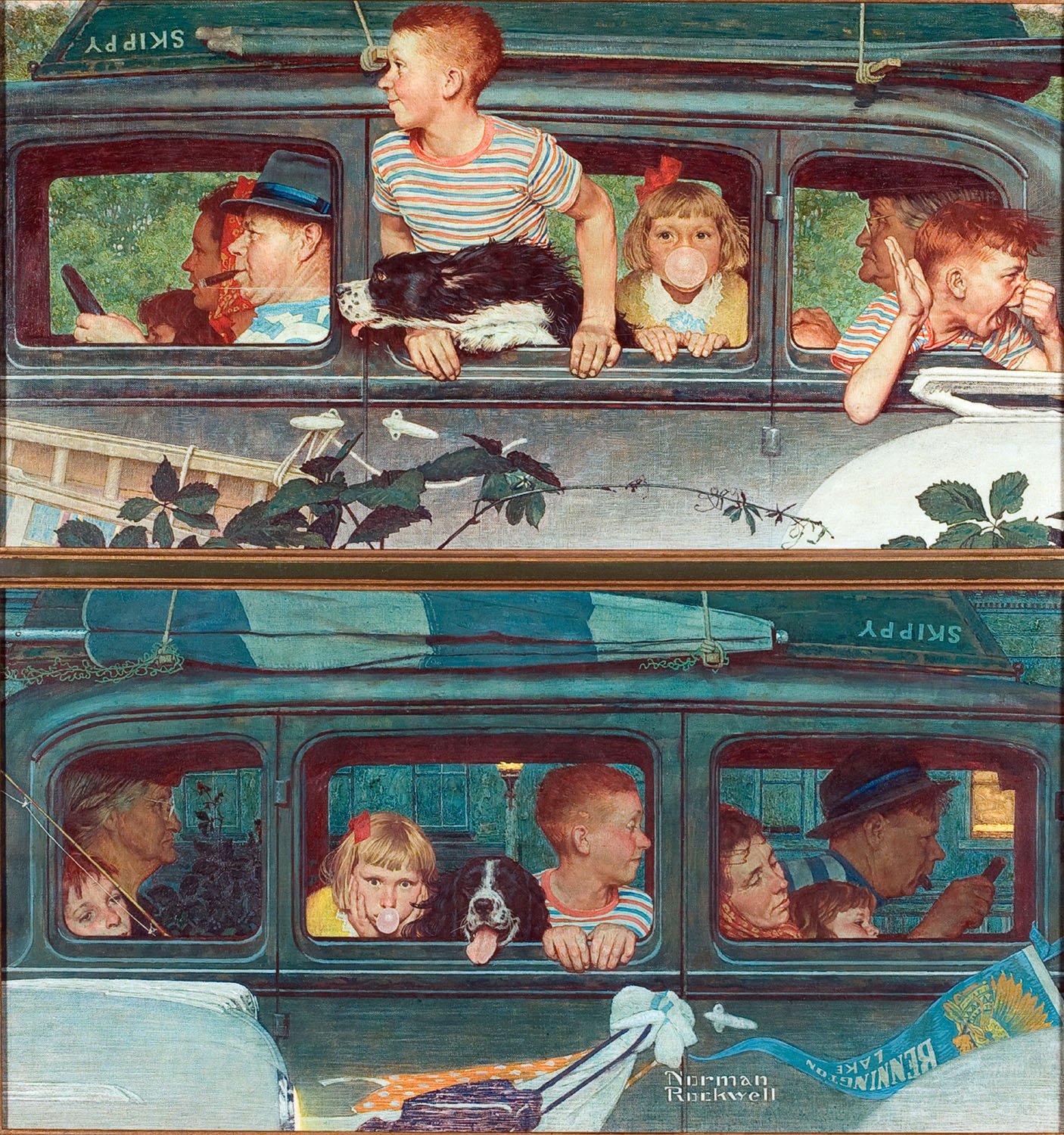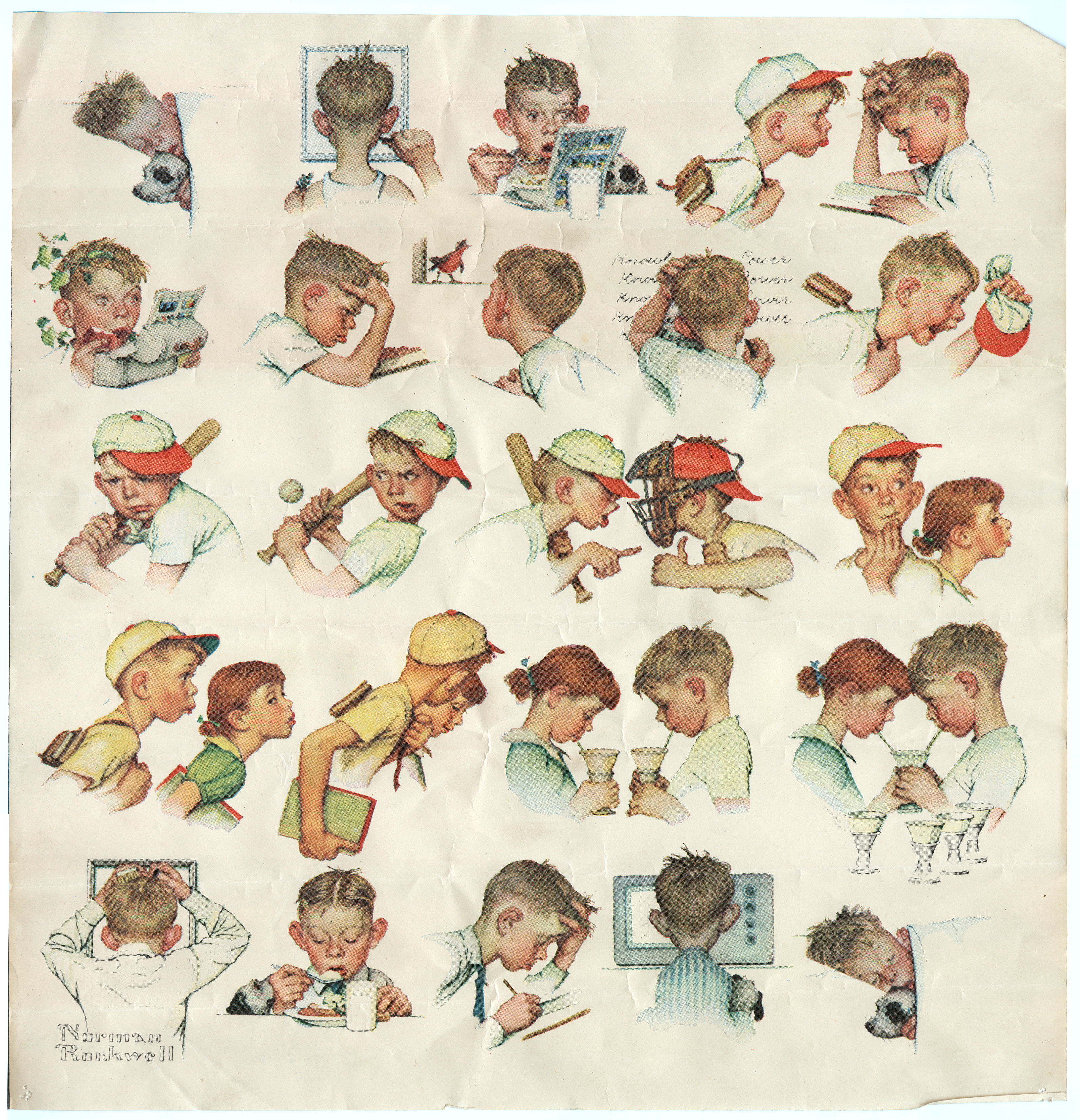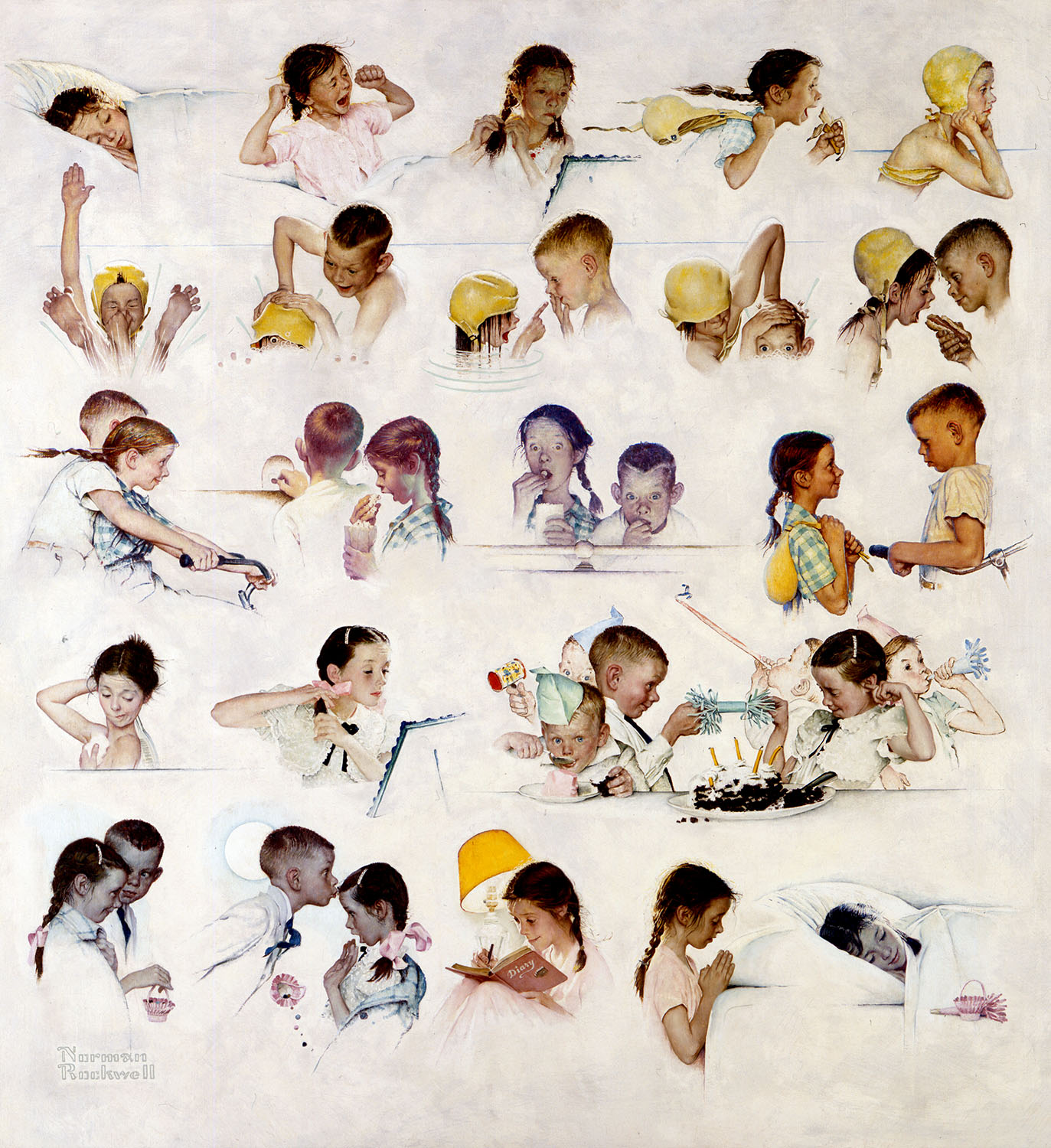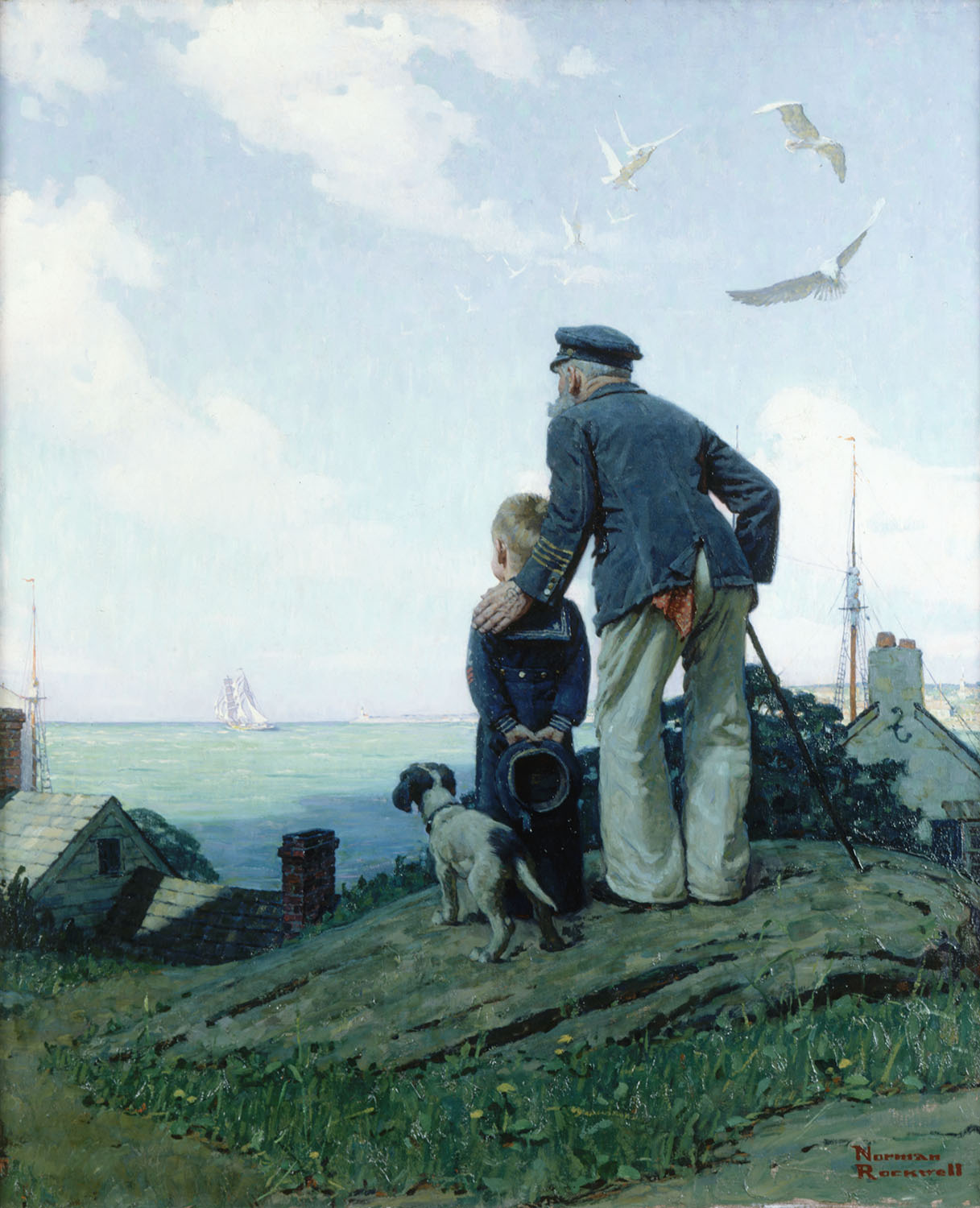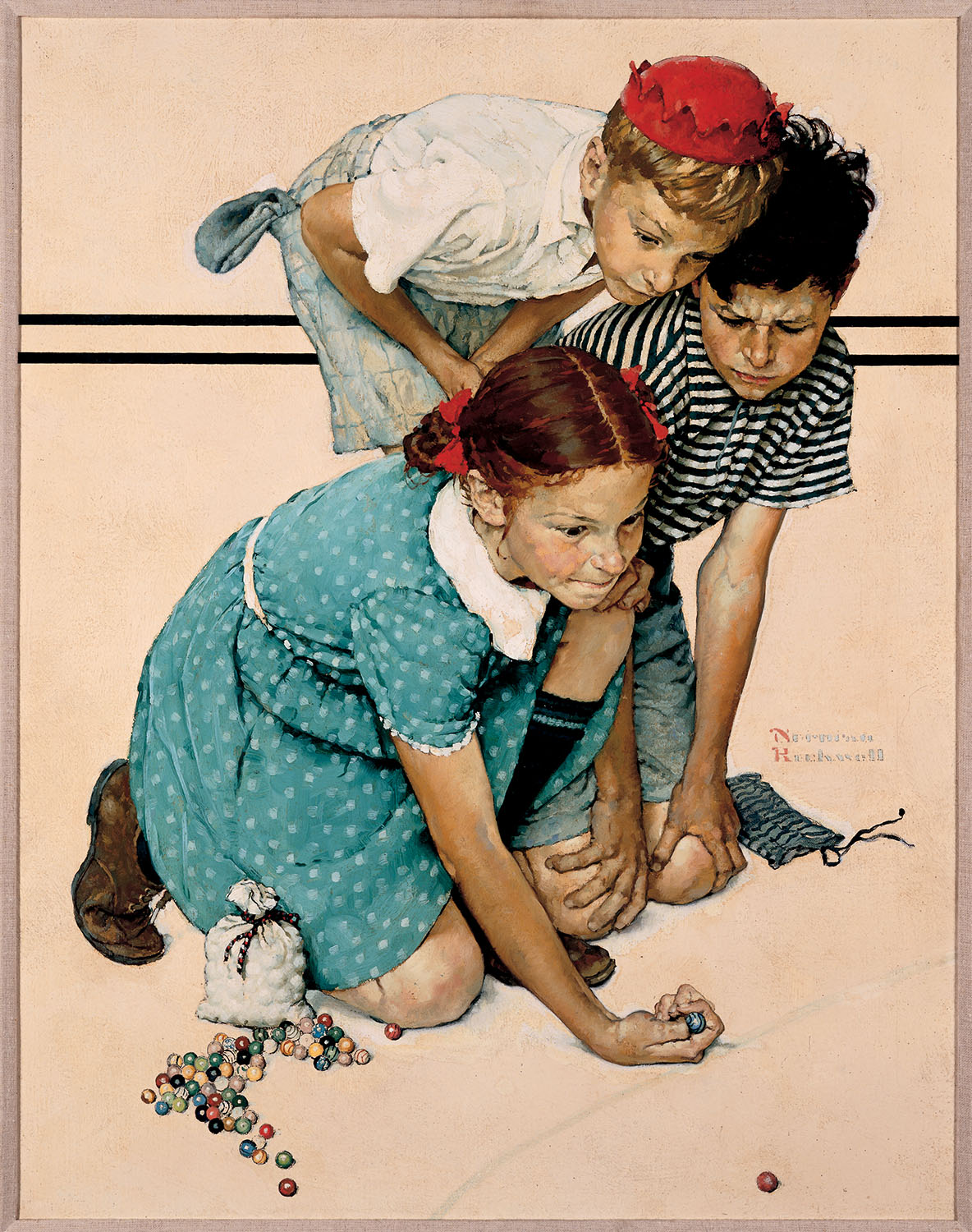Quick Pics: Journeys - Week of 4/20/2020
Overview - Journeys
Introduction and Welcome
This week our theme is journeys. Life is a journey and depending on how we choose to think about it each day, month, year we take expected and unexpected journeys. Some involve physical travel, others are journeys in time, unfold in the imagination or through creative processes like drawing or writing. Some are noticing journeys, like watching spring flowers come up in the yard. Sometimes a relationship or family experience can be a journey. Norman Rockwell and other illustrators paint images that invite us to think about the meaning of journeys we take. This week we’ll make looking at journeys in art its own special journey.
Going and Coming (1947)
Going and Coming painted by Rockwell in 1947. He shares a close look at the car ride a family takes to an outing and then home at the end of the day. How can you tell an adventure is about to unfold from the upper panel of the image? And what are the clues that it is the end of the day in the lower panel?
Notice and Wonder
- Look carefully at this picture - what story does it have to tell?
- What are the clues that in the top panel it is early in the day and the family is going somewhere?
- How can you tell they are on their way home in the bottom panel?
- How does the posture of each family member change from the top to the bottom panel?
- Going and Coming is one of Norman Rockwell’s two-part illustrations that show the passing of time in two frames. Which is the before and which is the after? Where might this family have gone and what did they do on their outing?
- We see the before and the after of the imagined event, a family’s summer outing by the lake. What clues does Rockwell offer to help us unravel the storyline?
- How does this family look on the way to their destination, and do they appear different on the way back? There is one person in the station wagon who has not changed at all - can you see who that is? While everyone including the family dog looks exhausted after their trip, Grandma appears to be just as calm and composed as she did on the way there.
- Rockwell owned a station wagon, which was big enough for his wife and three sons, but that is not the one he used in the painting.
- Notice light and shadow… How did Rockwell use light and shadow to show the beginning and end of the day?
Fun Facts
- No seatbelts places the picture in time…
- Rockwell photographed several automobiles for Going and Coming, but the one he wanted was driven by his mail carrier on his rounds. One day he met the man at the mailbox and told him to go up to the house where something awaited him. There the postman found a check for twenty-five dollars for the use of his car, which Rockwell had meanwhile taken to be photographed.
- Except for the automobile, the subjects for Going and Coming were photographed in Rockwell’s studio. The little girl’s name was Yvonne Cross, and the dad in the picture was Yvonne’s actual father.
What You Can Do
- Draw a picture and write a story about something you think happened on this family’s trip.
- Create a two panel drawing that shows a before and after scene. What scenario will you pick? Will it be a story about something that happened at home or at school, or on a visit with a friend? You can even add more panels if you want to show what happened in between!
Day in the Life... (1952)
Day in the Life of a Boy, May 24, 1952
We chose this image and it’s companion because it invites us to think about what made up a good day in 1952. What did this young boy do during the course of his day? Do you think his day includes a good mix of taking care of himself doing things like teeth brushing and eating, play, friend time and work? Is this day the same or different from your days?
Notice and Wonder
- According to Norman Rockwell, what are some of the things that happened in the course of this young boy’s day? Are there things in the picture that might be similar for you, and also different from your day?
- What is he having for breakfast? Does your lunch box look like that? Rockwell used what he called a “keyhole approach” to tell this hour by hour story about a day in this little boy’s life, from start to finish.
- His model was Chuck Marsh, the son of an Arlington, Vermont elementary school teacher, who lived near Rockwell. If you could insert yourself into one part of this picture, which would it be?
- What would you add or take away from this day to make your perfect day?
Fun Fact
- Norman Rockwell enjoyed working with child models because they were often great actors. He always paid them and also offered them a Coca-Cola, with their parents’ permission. When Chuck Marsh was born, Mary Rockwell, Norman’s wife, baby sat for him, so that his parents could do some holiday shopping. Arlington, Vermont was a very close knit community.
What Can You Do?
- Draw or write your typical day.Think about what good day feels like for you? How do you balance washing, eating, time with friends, family sports, reading and learning?
- If you were going to add variety to your day what would you change? What would you do less of and what would you add?
- Pick a detail from Rockwell’s painting that makes you laugh. What is funny about it? Do you have any memories or experiences that remind you of this picture?
- Did Norman Rockwell’s boy spend any time looking at screens? Is that the same or different from you?
Day in the LIfe of a Girl, August 30, 1952
Notice and Wonder
- In this picture, Norman Rockwell is telling what is called a sequential story, which gives us a sense of the many things that have happened in one little girl’s day.
- How did her day start, and how did it end? What are some of the things that happened in between, and how do you know? If you could insert yourself into this picture, what activity would you like to be a part of if you could?
- This is a companion painting to Day in the Life of a Little Boy, Norman Rockwell’s prior cover painting for the Post which was published three months earlier. It would seem that painting thirty-two heads is far more work than one or two, but to Rockwell, who loved painting expressive faces, telling a complete story using this method was far less difficult than painting a magazine cover with a detailed background. The events of the girl’s day were so typical to the American child that this cover could be appreciated by large numbers of viewers.
- When Rockwell was living in Arlington, Vermont from 1939 to 1953, Mary Whelan and Chuck Marsh were two of his very favorite models.
Fun Fact
- Rockwell’s model, Mary Whelan, arrived at Rockwell’s studio for a posing session for this picture one day. To her surprise, her neatly done hair was tousled for the opening frame in which she is seen waking up.
- As the model then rushes to school her mother lifts her braids as a second pair of hands pulls back her bathing suit and cap to indicate speed and motion. Whalen raises her eyebrows as high as they can go – an essential talent for any Rockwell model. Mary still owns the yellow bathing suit that she wears in this picture.
What You Can Do
Keep an hour by hour diary documenting the things that happen in your day, from the time that you wake up to the time you went to sleep. What are some of the things you did during that time? Draw your day, as Rockwell did in Day in the Life of a Girl and Day in the Life of a Boy.
Pirate Dreaming of Home (1924)
Notice and Wonder
- Big Idea - We go on journeys in our imagination, or through reading too! In this case the pirate's clothing tells a story which suggests big adventures, but it seems he is dreaming something else. Do some adventures ultimately make us dream of worlds that are less exciting and more cozy?
- BOOTS, sword, peg leg
- Composition element - halo or circle… a technique Rockwell often used to add to the story...
- Have you ever been on a journey to another place in your imagination? If so, where did you go? Was it as close as home or as far away as a distant planet?
- On the surface, this pirate’s life on the open sea appears to be full of adventure. If we look closely, it’s been difficult, too. What do you notice about his shirt and cape, and how might his leg have gotten injured? The color red in his cape and bandanna bring our attention straight to the pirate in very dramatic fashion.
What does this pirate dream of? Look carefully at the picture of the cozy cottage in the circle behind him, sometimes there’s just no place like home.
Fun Fact
- Rockwell loved to read classic stories as a boy and in adulthood, and Treasure Island by Robert Louis Stevenson was an inspiration. As the story goes, upon finding a map in his parents' inn, young Jim Hawkins joins a crew on route to the Caribbean to find buried treasure. One of his crew, the charming, yet devious Long John Silver is determined to take the treasure for himself. Two of Rockwell’s favorite illustrators Howard Pyle and N.C. Wyeth created artwork for the book, and their portrayals of pirates fascinated Rockwell.
- Signed in blood conscious on his part
- Circle element part of The Saturday Evening Post
What You Can Do
- Is there a place that you dream of going? And where is the place you dream of, or go to, for safe and cozy times?
- Draw a picture of yourself with a thought bubble, and fill it in with a picture of description of the place you’d like to go.
Outward Bound - or The Stay at Homes (1927)
We chose this image because it invites us to think about the relationship between older and younger generations. The relationships in our lives can be a wonderful part of our life journey. How do older people in your life give you perspective and help you think about your life journey? How can young people learn from and support the older members of their family?
Notice and Wonder
- Look carefully at this picture - what story about a journey is Rockwell trying to tell.
- Why might the boy and older man, and even the dog, be looking out to sea? What do they see on the horizon?
- Norman Rockwell’s grandfather, John Rockwell, does not specifically appear as a model in his many pictures of elderly men, but a loving grandfather-grandchild relationship is often seen in his work. Rockwell enjoyed working with children and older adults because he felt they were less self-conscious and freer to act out feelings and emotions. What aspects of the picture, whether poses or clothing, show the connection between the boy and the man?
- From the light in this picture, what time of day might it be? If you could insert yourself into this picture, who might you be standing next to, and what would you be looking at in the distance?
Fun Fact
- The part of the picture that appears closest to us, called the foreground, was inspired by an actual setting in New England. In the summer of 1912, Rockwell spent three months studying painting out of doors with artist Charles Hawthorne in Provincetown, Massachusetts, which was then a fishing village.
- The house on the right looks just like Norman Rockwell’s own studio in New Rochelle, New York, which had been built as an attachment to his garage earlier that year.
What You Can Do
- If you did a recreation based on your life, who is the adult, are there animals? Where are you looking?
- Recreate this Norman Rockwell painting to reflect your own experience taking in a scene with a friend or family member. Where will you be standing and what do you see in the distance? What are you imaging as you look out? You might even have a friend take a picture of your re-creation.
Marble Champion (1939)
Sometimes a good game can be its own kind of journey with a beginning, middle and end. In this image the children are playing a game and someone is winning, but the game isn’t over yet. If you’ve ever played a board game or playground game where you winning or losing are involved you will likely identify with the children in this image.
Notice and Wonder
- What’s happening in this picture? What game might the children be playing, and who appears to be winning? What are the clues that tell you that?
- Notice the expressions on each child’s face. Who is determined? Who is wondering how this could be happening?
- She has bows in her hair and she’s wearing a dress, but her scuffed shoes and bruised knee show that she’s playing with everything she’s got.
- This is the end of a game of marbles.
- Players put their marbles in the center of a ring.
- Players “shoot” a into the ring to knock marbles out of the ring. Every marble shot out of the ring becomes a point.
- Even though there is no specific background in this picture, do they appear inside or outside, and what gives you that sense?
- Who appears to be an expert winning the most points?
Her stuffed marble bag compares to the boys’ empty sacs, and her determined expression indicates that she has only just begun.
How do you get good at something? Practice, practice, practice, especially if it’s something that you love to do.
Fun Fact
- Norman Rockwell grew up in New York City where flat cement sidewalks were the perfect surface for playing marbles, ball, and other outdoor games for a few or many children.
- This image was made in 1939. Humans love to play games and we learn from winning, losing and being in conversation. Games can be simple and still be fun.
- Paid careful attention to the shooters’ hand. We can tell she has practiced and through her expression and hand position we can know she is determined and a strong player. If the hand position were off, he would have received letters from people who saw his image in the saturday evening post.
- The artist’s son Jarvis, seen here in the red cap, was a model for this picture.
What You Can Do
- Notice the games you love to play. Think about what it means to be a friendly competitor, and also determined. What are the games you want to become expert at?
Image Resources
Going and Coming (August 30, 1947)
Day in the Life of a Boy (May 24, 1952)
Day in the Life of a Girl (August 30, 1952)
Pirate Dreaming of Home (August 30, 1924)
Outward Bound - or The Stay at Homes (October 1927)
Marble Champion (September 2, 1939)
Image Credits:
Marble Champion (Girl Playing Marbles), 1939
Norman Rockwell (1894 - 1978)
Oil on canvas
Cover illustration for The Saturday Evening Post, September 2, 1939
Private Collection
© 1939 SEPS: Curtis Licensing, Indianapolis, IN
A Day in the Life of a Boy, 1952
Norman Rockwell (1894 - 1978)
Oil on canvas
Cover illustration The Saturday Evening Post, May 24, 1952
©1952 SEPS: Curtis Licensing, Indianapolis, IN
A Day in the Life of a Girl, 1952
Norman Rockwell (1894 - 1978)
Oil on canvas
Cover illustration The Saturday Evening Post, August 30, 1952
Norman Rockwell Museum Collection
©1952 SEPS: Curtis Licensing, Indianapolis, IN
Pirate Dreaming of Home, 1924
Norman Rockwell (1894 - 1978)
Oil on canvas
Cover illustration The Saturday Evening Post, August 30, 1924
Private Collection
Outward Bound (The Stay at Homes), 1927
Norman Rockwell (1894 - 1978)
Oil on canvas
Painting for Ladies' Home Journal illustration, October 1927
Norman Rockwell Museum Collection
© 1927 Norman Rockwell Family Agency
Going and Coming, 1947
Norman Rockwell (1894 - 1978)
Oil on canvas
Cover illustration The Saturday Evening Post, August 30, 1947
Norman Rockwell Museum Collection, NRACT.1973.9
©1947 SEPS: Curtis Licensing, Indianapolis, IN
- Grade
- K-6
- Theme
- Quick Pics
- Length
- Each Quick Pic activity is about 5-10 minutes in duration, with each being taught one image per day over a week.
- Discipline
- Social Studies, Language Arts: Speaking and Listening, Art
- Vocabulary
- Journey, Journeys, Travel, Trip, Friendships, Day, Work, Relationships, Imagination
Standards
This curriculum meets the standards listed below. Look for more details on these standards please visit: ELA and Math Standards, Social Studies Standards, Visual Arts Standards.
- CCSS.ELA-Literacy.CCRA.L.1
- Demonstrate command of the conventions of standard English grammar and usage when writing or speaking.
- CCSS.ELA-Literacy.CCRA.L.2
- Demonstrate command of the conventions of standard English capitalization, punctuation, and spelling when writing.
- CCSS.ELA-Literacy.CCRA.L.3
- Apply knowledge of language to understand how language functions in different contexts, to make effective choices for meaning or style, and to comprehend more fully when reading or listening.
- CCSS.ELA-Literacy.CCRA.L.4
- Determine or clarify the meaning of unknown and multiple-meaning words and phrases by using context clues, analyzing meaningful word parts, and consulting general and specialized reference materials, as appropriate.
- CCSS.ELA-Literacy.CCRA.L.5
- Demonstrate understanding of figurative language, word relationships, and nuances in word meanings.
- CCSS.ELA-Literacy.CCRA.L.6
- Acquire and use accurately a range of general academic and domain-specific words and phrases sufficient for reading, writing, speaking, and listening at the college and career readiness level; demonstrate independence in gathering vocabulary knowledge when encountering an unknown term important to comprehension or expression.
- CCSS.ELA-Literacy.CCRA.SL.1
- Prepare for and participate effectively in a range of conversations and collaborations with diverse partners, building on others' ideas and expressing their own clearly and persuasively.
- CCSS.ELA-Literacy.CCRA.SL.2
- Integrate and evaluate information presented in diverse media and formats, including visually, quantitatively, and orally.
- CCSS.ELA-Literacy.CCRA.SL.3
- Evaluate a speaker's point of view, reasoning, and use of evidence and rhetoric.
- CCSS.ELA-Literacy.CCRA.SL.4
- Present information, findings, and supporting evidence such that listeners can follow the line of reasoning and the organization, development, and style are appropriate to task, purpose, and audience.
- CCSS.ELA-Literacy.CCRA.SL.5
- Make strategic use of digital media and visual displays of data to express information and enhance understanding of presentations.
- CCSS.ELA-Literacy.CCRA.SL.6
- Adapt speech to a variety of contexts and communicative tasks, demonstrating command of formal English when indicated or appropriate.
